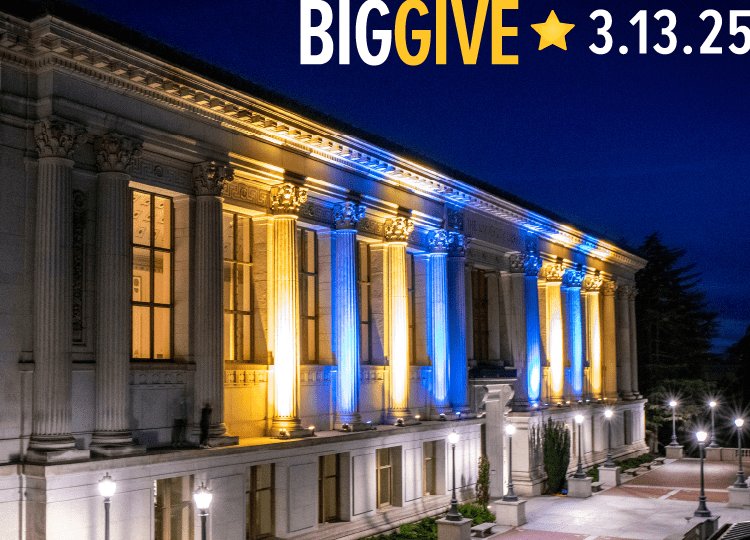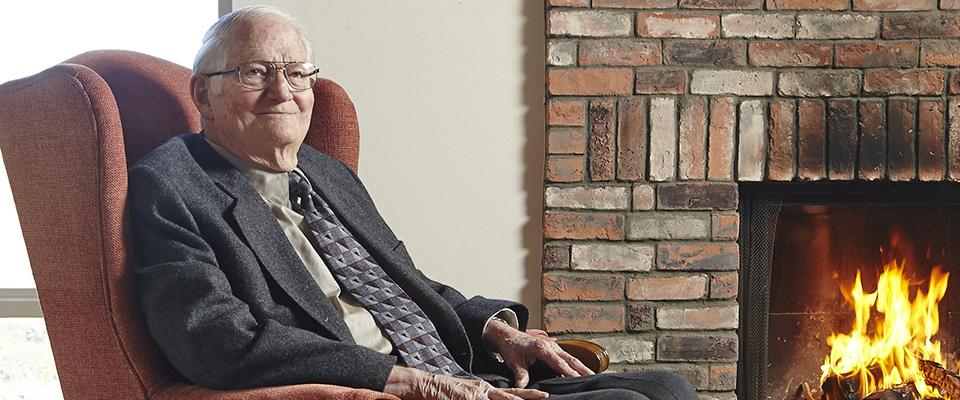Best known for biochemical research, Alumnus of the Year Frank Davis has turned his hand to a variety of tasks.
The wide reach of Frank Davis’s achievements and travels pretty much necessitates a search engine, and he tends to punctuate his sentences with the smiling exhortation, “You could look it up!”
Davis, like some hero from historical fiction, cut a wide-ranging path through the 20th century: Depression-era farmer, wartime globetrotter, chemist in the biochemical revolution, pharmaceutical pioneer, corporate executive. Through it all emerges a man of uncommon resourcefulness, a success both with his hands and his mind, equally capable of conversing about both nucleotide chromatography and the art of laying tile floor. For his lifetime of achievement, Davis has been named the 2013 Cal Alumni Association’s Alumnus of the Year, joining the ranks of such notable Berkeley graduates as Nobel Laureate Glenn Seaborg, Ph.D. ’37, author Joan Didion ’56, and Donald Fisher ’50, who founded The Gap.
Now 92, retired to the West Coast after 30 years in New Jersey, Davis can reflect on a life that’s taken him more places than he can remember. You really would have to look it up.
You’ll find Hermiston, Oregon, where Davis grew up, 200 miles east of Portland not far from the Columbia River Gorge. Just to the south is Pendleton, the small Indian town where Davis was born in 1920. His father was a civil engineer, one of the men who had moved to arid eastern Oregon to bring water to the desert. Sitting in his El Cerrito living room and with an eye on a squirrel raiding the backyard birdfeeder, Davis pulls out a two-volume Hermiston history and gingerly runs a finger over the black-and-white photos on the cover. Head down, drawn in by memories of his childhood, he opens the book and starts to read, chuckling at old cartoons and calling out familiar landmarks.
After high school, Davis worked on his grandparents’ dairy farm. “Piece of advice,” he says, “Don’t ever start a dairy farm if you can’t afford hired help.”
Milking cows wasn’t the kind of thing he wanted to do forever. So in the spring of 1940, Davis loaded a Model A Ford with all his possessions and, a friend alongside, drove south for three days to Los Angeles. His mother had enrolled him in Anderson Airplane School, which he thinks she found in a catalog. “It practically guaranteed you a job,” he remembers, and during the Great Depression, the prospect of a job counted for everything.
The school delivered on its guarantee. Frank Davis wouldn’t return to Hermiston.
In 1942, Davis was working in the experimental assembly department at Douglas Aircraft in Santa Monica, tinkering with DB-7 and A-20 planes, when the company held a contest to design a better engine cowling. Davis hand-jigged one; his bosses liked it and rewarded his ambition by signing him up for a trip to North Africa. “Next thing I knew,” he says, Douglas had “entered me in their foreign service.”
Davis had been inducted into Project 19, a secret partnership between the English and Americans in which Douglas mechanics fixed English warplanes from a covert base in Gura, Eritrea. But by the time Davis arrived in Gura in 1943, the war was turning. Within months, he was on the move again to the Persian Gulf oil city of Abadan, Iran, to assemble fighter planes for the Russians. And as the war became concentrated in Western Europe, he took a job at Lockheed in Northern Ireland. A few months into his work at Langford Lodge, an RAF base outside of Belfast, he was drafted into the Navy.
Davis displays his Navy photo in his living room. The young man looking back at you in his sailor uniform has Davis’s classic straight nose, birdlike eyes, and a perfectly clean-shaven chin, a sharp contrast to the full beard he would later grow.
The Navy sent him first to Dunkeswell, Devonshire, for training—”You’ll find it on the Google,” he says, and then, smiling, “I can relive my life on Google”—and then to Boca Chica Key, Florida, to service sub patrol planes for a few months. He was then ordered to Japan to join a planned invasion, but only made it as far as Honolulu. And then the war ended.
So there Davis was in Hawaii, at 25 years old, four continents visited, 3,000 miles from eastern Oregon, and with this chapter of his life closing, already holding a lifetime of memories. It wasn’t obvious what to do next. Davis described himself at the time as somewhat “at loose ends.”
But he had someone to help him with the transition. On New Year’s Eve, 1946, Davis went to a party with his older sister and her roommate, an adventurous farm girl from South Dakota named Kay Hay.
Frank and Kay were married two years later. A black-and-white wedding photo sits on the table as counterpoint to the Navy enlistment photo: Frank standing straight in a broad-shouldered gray suit, Kay at his side with a flower in her hair.
Wherever Davis’s remarkable life would take him next, until Kay’s death in 2009 he’d have a traveling companion.
Although he’d found success as a mechanic, Frank Davis had always been drawn to chemistry and the hard sciences. So after the war, he enrolled as a chemistry student at the University of Hawaii. Four years later, he moved to Berkeley to get his doctorate in the lab of nucleic acid biochemist Frank Worthington Allen.
For years, the field had been mostly quiet—”not dormant,” Davis says, searching for the right word, “but not dynamic.” Davis, who joined Allen in 1950, recalls the day in 1953 when Allen walked through the lab with “three fellows who had just published two papers in Nature.” The papers, Davis remembers, came stapled together, A and B. The top one was titled something like “The Double Helical Structure of DNA.” The three fellows were James Watson, Francis Crick, and Maurice Wilkins. In less than a decade, those stapled papers would win them the Nobel Prize.
During his time at Cal, Davis says the nucleic acid field became “white hot.” He remembers big meetings, big talks, symposia … “running to the library to see every new issue of the journals.”
That, too, was the advantage of Berkeley. “The quality of the teaching was exceptional,” Davis recalls. His instructors were up on the very latest science, offering him an education that would give him an edge for the rest of his career.
He could have filed for his doctorate in 1954, but instead of graduating, he chose to continue examining RNA’s bases. The more he looked, the more it seemed there was something new emerging in the chromatography data. Davis and Allen published the results in a 1957 paper in the Journal of Biological Chemistry, describing an “unknown” nucleoside that they and others would later label pseudouridine. Davis then moved on, leaving others to describe the nucleoside and its function—which, if you look it up, still isn’t entirely understood.
Following graduation and a two-year postdoctoral fellowship split between Berkeley and the new UCSF Medical Center, Davis hoped to stay at Cal. But a mentor, he recalls, told him the University wouldn’t consider anyone over the age of 29 for a tenure-track job. Davis was 37. Rutgers, which had just become New Jersey’s public university, came calling with a tenured position in agricultural biochemistry—the closest position they had that matched Davis’s background. He could use his Cal training to build a department.
In 1958, Davis and Kay and their two young children, Paul and Ann, moved to New Brunswick, New Jersey, to start the next chapter of their lives.
Although he continued his nucleic acid research at Rutgers, Davis became interested in other problems in biochemistry. There was a heavy pharmaceutical presence in New Jersey, and he started to think about one problem in particular: how to get healing drugs into the body. The issue was that the immune system, trained to sniff out foreign agents, tries to annihilate them immediately. Davis figured out a way around this. There was a certain compound, polyethylene glycol (PEG), that resisted the body’s defenses. Davis called it a “happy-go-lucky” little enzyme, and he realized that if you could “peg” a drug, you could solve the problem.
Davis and researcher Theo van Es tested the enzyme on mice. The technique they called PEGylation worked. Davis quickly published his results and filed for a patent. Search, and you’ll find it: U.S. patent number 4,179,337, non-immunogenic polypeptides, approved on December 18, 1979. Davis soon ran into a problem, though. He didn’t have the money to take his therapy beyond mice. He needed the attention of one of the big pharmaceutical companies, but they weren’t interested. He recalled how the university’s vice president for research and development finally came to him one day and said, “Well, there’s only one way left that we can see. You have to start your own company.”
Davis and a graduate student, Abraham Abuchowski, started a small company called Enzon. The first challenge was finding a way to test PEGylation on humans. Abuchowski came up with the idea to conduct trials under the Orphan Drug Act, which streamlined and simplified the process for companies testing drugs on people with rare diseases.
We didn’t need to look up the Orphan Drug Act. On the second day I visited Davis, he had the information sitting on his lap, in an article from an old New York Times. It highlighted the trend of pharmaceutical companies increasingly using and profiting from orphan drugs. Enzon, without intending it, had been a pioneer.
In the early 1980s, Michael Hershfield, an expert at Duke University in rare genetic diseases, was investigating the cause of severe combined immunodeficiency disease. SCID arises when patients lack a protein called adenosine deaminase, or ADA. The result is an almost total lack of function in the immune system. Back then, babies born with SCID had to receive a bone marrow transplant from a well-matched donor, or be placed immediately in a sterile environment.
Hershfield remembers walking to his car one fall day in 1985 and running into the head of Duke’s pediatric immunology department, Rebecca Buckley. Buckley had an envelope from a New Jersey company looking for patients to try a new therapeutic technique. Hershfield had a candidate: a little girl with SCID who’d already received two unsuccessful bone marrow transplants.
“By this time, she had been sent home and there was nothing more that could be done,” Hershfield said. “She was very sick, on oxygen. She was not going to survive.”
The following spring, someone from Enzon flew to North Carolina with a vial of what they called PEG-ADA—a “pegged” version of the enzyme the girl lacked. Hershfield and Buckley administered the treatment and watched the girl’s lymphocyte count start to rise. They quickly identified another patient who could use it, a girl in Nebraska who was surviving on monthly blood transfusions. The PEG-ADA helped her, too. Hershfield and Buckley sent their results to New England Journal of Medicine and published.
Enzon, and Frank Davis, had found a new way of treating SCID.
“This woke up the big boys,” Davis says. “They didn’t think much of the mouse work, maybe, but it worked in humans.”
PEGylation is now widely used to treat a range of ailments, including chemotherapy side effects and Hepatitis C.
By the time the pharmaceutical industry started knocking on Enzon’s door, Davis had already retired to the West Coast, so he didn’t make any money on the ensuing deals. He did, however, retain a lot of stock in Enzon after it went public in 1984. Late in the 1990s, the stock of the pharmaceutical giant Amgen, which now makes several of the most profitable PEG drugs, started climbing—with Enzon right behind. After trading at around $10 a share through most of the ’80s and all of the ’90s, Enzon hit $80 on November 3, 2000. Finally, Frank Davis was able to cash in on his biotech career.
Until recently, when he began to slow down—a man in his tenth decade, after all, deserves some down time—Davis’s retirement featured the sort of physical and mental labors befitting a man with his background. He proudly points out home-improvement projects he’s completed around his house in El Cerrito, from floor tile to the giant TV that he hung on the wall. He kept both a wood shop and a metal shop in his garage, and fondly recalls crawling under the house to anchor the foundation. He also liked to cook—Chinese was his favorite, he says, though his daughter, Ann, remembers his sourdough bread, which Frank used to make in special bread pans he fashioned himself.
He reads quite a bit, and the table next to his chair reflects his intellectual interests: The New York Times, National Geographic, Science, Wine Spectator. Photos of Frank, Kay, and his grandchildren adorn the walls and tables, and he has a standing weekly Scrabble date with Ann, 57.
The man whose life has taken him far and wide doesn’t really need much more than a search engine these days. Ann got him an iPad for Christmas, but he doesn’t have a smart phone.
“I don’t have a phone—well, I have a portable phone, but not the little flat thing,” he says. “Beyond being able to turn the thing on and get Google and Wikipedia … that’s about as far as I go.”





















